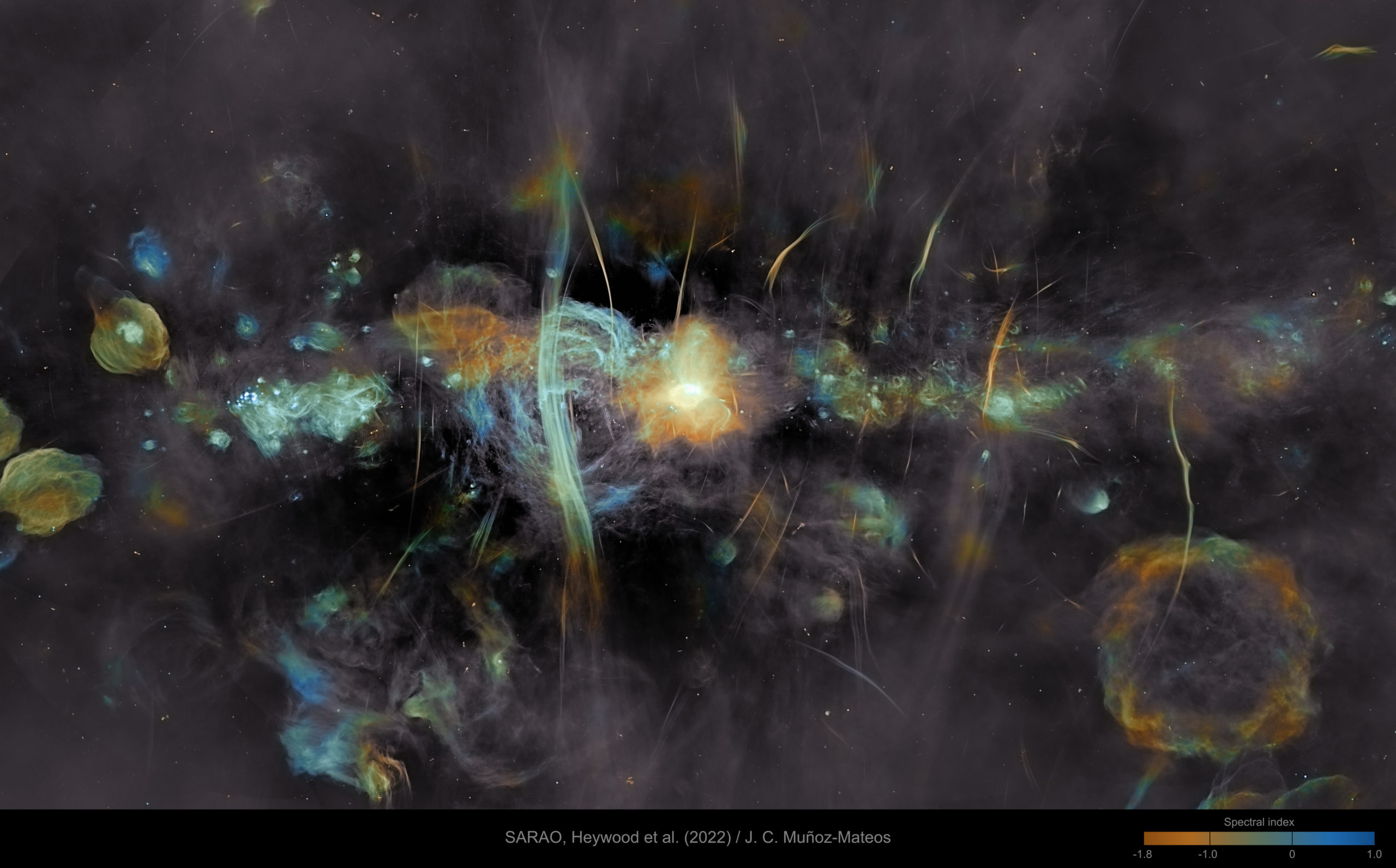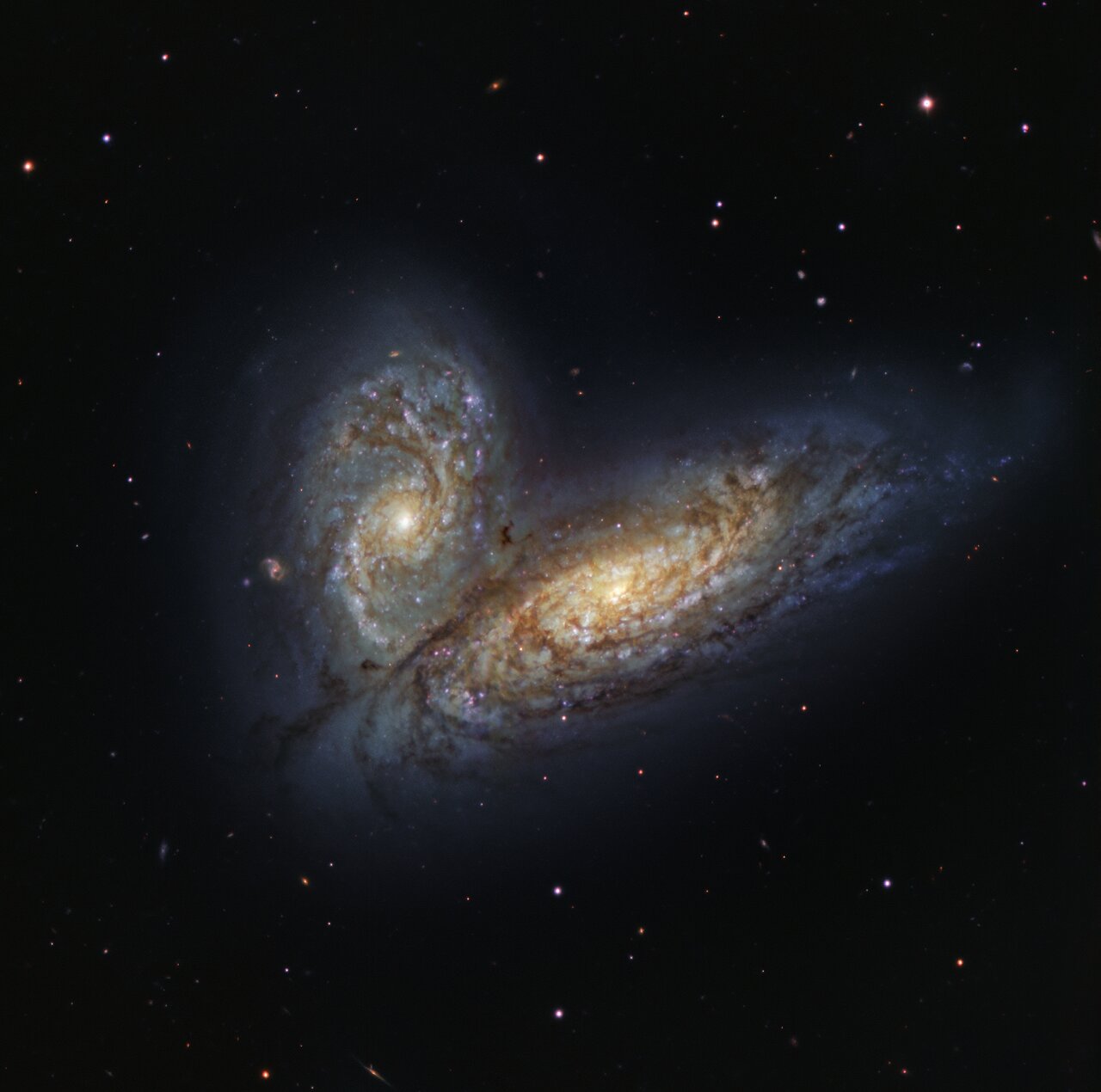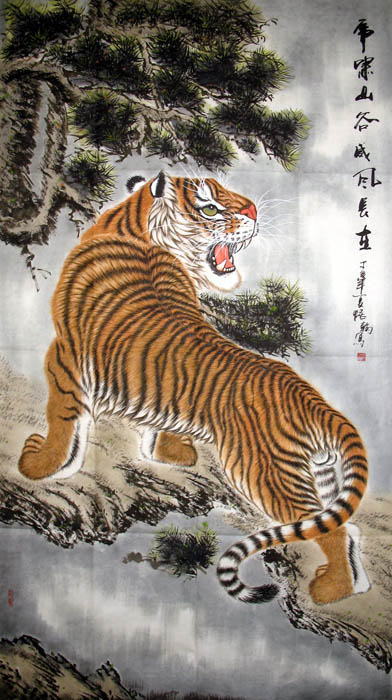Blog
What’s happening at the center of our galaxy? It’s hard to tell with optical telescopes since visible light is blocked by intervening interstellar dust. In other bands of light, though, such as radio, the galactic center can be imaged and shows itself to be quite an interesting and active place. The featured picture shows the latest image of our Milky Way’s center by the MeerKAT array of 64 radio dishes in South Africa. Spanning four times the angular size of the Moon (2 degrees), the image is impressively vast, deep, and detailed. Many known sources are shown in clear detail, including many with a prefix of Sgr, since the galactic center is in the direction of the constellation Sagittarius. In our Galaxy’s Center lies Sgr A, found here in the image center, which houses the Milky Way’s central supermassive black hole. Other sources in the image are not as well understood, including the Arc, just to the left of Sgr A, and numerous filamentary threads. Goals for MeerKAT include searching for radio emission from neutral hydrogen emitted in a much younger universe and brief but distant radio flashes.

more...
Graham William Nash OBE (born 2 February 1942) is a British-American singer-songwriter and musician. Nash is known for his light tenor voice and for his songwriting contributions as a member of the English pop/rock group the Hollies and the folk-rock supergroups Crosby, Stills & Nash and Crosby, Stills, Nash & Young. Nash became an American citizen on 14 August 1978 and holds dual citizenship with the United Kingdom and the United States.
Nash is a photography collector and a published photographer. He was inducted into the Rock and Roll Hall of Fame as a member of Crosby, Stills & Nash in 1997 and as a member of the Hollies in 2010.
Nash was appointed an Officer of the Order of the British Empire (OBE) in the 2010 Birthday Honours List for services to music and to charity.
Nash holds four honorary doctorates, including one from New York Institute of Technology, one in Music from the University of Salford in 2011 and his latest Doctorate in Fine Arts from Lesley University in Cambridge, Massachusetts.
more...James “Blood” Ulmer (born February 8, 1940) is an American jazz, free funk and blues guitarist and singer. Ulmer plays a Gibson Byrdland guitar. His guitar sound has been described as “jagged” and “stinging”. His singing has been called “raggedly soulful”.
Willie James Ulmer was born in St. Matthews, South Carolina, United States. He began his career playing with soul jazz ensembles, first in Pittsburgh, Pennsylvania, from 1959 to 1964, and then in the Columbus, Ohio, area from 1964 to 1967. He recorded with organist Hank Marr in 1964 (released 1967). After moving to New York in 1971, Ulmer played with Art Blakey‘s Jazz Messengers, Joe Henderson, Paul Bley, Rashied Ali, and Larry Young.
more...
Stanley Gayetski (February 2, 1927 – June 6, 1991), professionally known as Stan Getz, was an American jazz saxophonist. Playing primarily the tenor saxophone, Getz was known as “The Sound” because of his warm, lyrical tone, with his prime influence being the wispy, mellow timbre of his idol, Lester Young. Coming to prominence in the late 1940s with Woody Herman‘s big band, Getz is described by critic Scott Yanow as “one of the all-time great tenor saxophonists”. Getz performed in bebop and cool jazz groups. Influenced by João Gilberto and Antônio Carlos Jobim, he popularized bossa nova in the United States with the hit single “The Girl from Ipanema” (1964).
Stan Getz was born on February 2, 1927, at St. Vincent’s Hospital in Philadelphia, Pennsylvania, United States. Getz’s father Al was born in Mile End, London, in 1904, while his mother Goldie (née Yampolsky) was born in Philadelphia in 1907. His paternal grandparents Harris and Beckie Gayetski were originally from the Kiev area of the Russian Empire (now Ukraine) but had migrated to escape the anti-Jewish pogroms in the Russian Empire to Whitechapel, in the East End of London. While in England they owned the Harris Tailor Shop at 52 Oxford Street for more than 13 years. In 1913, Harris and Beckie emigrated to the United States with their three sons Al, Phil, and Ben, following their son Louis Gayetski who had emigrated to the US the year before.
more...Edward Hammond Boatner Jr. (February 2, 1924 – July 22, 1982), known professionally as Sonny Stitt, was an American jazz saxophonist of the bebop/hard bop idiom. Known for his warm tone, he was one of the best-documented saxophonists of his generation, recording more than 100 albums. He was nicknamed the “Lone Wolf” by jazz critic Dan Morgenstern because of his relentless touring and devotion to jazz yet rarely worked with the same musicians for long. Stitt was sometimes viewed as a Charlie Parker mimic, especially earlier in his career, but gradually came to develop his own sound and style, particularly when performing on tenor saxophone.
Edward Hammond Boatner, Jr. was born in Boston, Massachusetts, and grew up in Saginaw, Michigan. He had a musical background: his father, Edward Boatner, was a baritone singer, composer, and college music professor; his brother was a classically trained pianist, and his mother was a piano teacher. He was given up for adoption in 1924 by his father and adopted by the Stitt family in Saginaw. He later began calling himself “Sonny”. While in high school in Saginaw, he played in the Len Francke Band, a local popular swing band.
more...The dwarf galaxy NGC 1705 is featured in this image from the NASA/ESA Hubble Space Telescope. This diminutive galaxy lies in the southern constellation Pictor, and is approximately 17 million light-years from Earth. NGC 1705 is a cosmic oddball — it is small, irregularly shaped, and has recently undergone a spate of star formation known as a starburst. Despite these eccentricities, NGC 1705 and other dwarf irregular galaxies like it can provide valuable insights into the overall evolution of galaxies. Dwarf irregular galaxies tend to contain few elements other than hydrogen or helium, and are considered to be similar to the earliest galaxies that populated the Universe. The data shown in this image come from a series of observations designed to unveil the interplay between stars, star clusters, and ionised gas in nearby star-forming galaxies. By observing a specific wavelength of light known as H-alpha with Hubble’s Wide Field Camera 3, astronomers aimed to discover thousands of emission nebulae — regions created when hot, young stars bathe the clouds of gas surrounding them in ultraviolet light, causing them to glow. This is not the first time that NGC 1705 has been imaged by Hubble — astronomers peered into the heart of the galaxy in 1999 using Hubble’s workhorse camera at the time, the Wide Field Planetary Camera 2. This instrument was replaced with the Wide Field Camera 3 during the fifth and final Space Shuttle mission to Hubble in 2009, and the newer instrument has provided a richer and far more detailed portrait of NGC 1705 than the 1999 observation.

Dennis Emmanuel Brown CD (1 February 1957 – 1 July 1999) was a Jamaican reggae singer. During his prolific career, which began in the late 1960s when he was aged eleven, he recorded more than 75 albums and was one of the major stars of lovers rock, a subgenre of reggae. Bob Marleycited Brown as his favourite singer, dubbing him “The Crown Prince of Reggae”, and Brown would prove influential on future generations of reggae singers.
Dennis Brown was born on 1 February 1957 at the Victoria Jubilee Hospital in Kingston, Jamaica. His father Arthur was a scriptwriter, actor, and journalist, and he grew up in a large tenement yard between North Street and King Street in Kingston with his parents, three elder brothers and a sister, although his mother died in the 1960s. He began his singing career at the age of nine, while still at junior school, with an end-of-term concert the first time he performed in public, although he had been keen on music from an even earlier age, and as a youngster was a keen fan of American balladeers such as Brook Benton, Sam Cooke, Frank Sinatra, and Dean Martin. He cited Nat King Cole as one of his greatest early influences. He regularly hung around JJ’s record store on Orange Street in the rocksteady era and his relatives and neighbours would often throw Brown pennies to hear him sing in their yard. Brown’s first professional appearance came at the age of eleven, when he visited “Tit for Tat” a local West Kingston Nightclub where his brother Basil was performing a comedy routine, and where he made a guest appearance with the club’s resident group, the Fabulous Falcons (a group that included Cynthia Richards, David “Scotty” Scott, and Noel Brown). On the strength of this performance he was asked to join the group as a featured vocalist. When the group performed at a JLP conference at the National Arena, Brown sang two songs – Desmond Dekker‘s “Unity” and Johnnie Taylor‘s “Ain’t That Loving You” – and after the audience showered the stage with money, he was able to buy his first suit with the proceeds.Bandleader Byron Lee performed on the same bill, and was sufficiently impressed with Brown to book him to perform on package shows featuring visiting US artists, where he was billed as the “Boy Wonder”. In the late 1990s, Brown’s health began to deteriorate. He had developed respiratory issues, probably exacerbated by longstanding problems with drug addiction, mainly cocaine, leading to him being taken ill in May 1999 after touring in Brazil with other reggae singers, where he was diagnosed with pneumonia. After returning to Kingston, Jamaica, on the evening of 30 June 1999, he was rushed to Kingston’s University Hospital, suffering from cardiac arrest. Brown died the next day, the official cause of his death was a collapsed lung. Sitting Jamaican Prime Minister P. J. Patterson and former prime minister, serving at the time as opposition leader, Edward Seaga of the Jamaica Labour Party both spoke at Brown’s funeral, which was held on 17 July 1999 in Kingston. The service, which lasted for three hours, also featured live performances by Maxi Priest, Shaggy, and three of Brown’s sons. Brown was then buried at Kingston’s National Heroes Park. Brown was survived by his wife Yvonne and ten children.
more...James Ambrose Johnson Jr. (February 1, 1948 – August 6, 2004), better known by his stage name Rick James, was an American singer-songwriter, multi-instrumentalist and record producer. Born and raised in Buffalo, New York, James began his musical career in his teen years. He was in various bands before entering the U.S. Navy Reserve to avoid being drafted into the army. In 1964, James deserted to Toronto, Canada, where he formed the rock band the Mynah Birds, who eventually signed a recording deal with Motown Records in 1966. James’ career with the group halted after military authorities discovered his whereabouts and eventually convicted and sentenced James to a one-year prison term related to the desertion charges. After being released, James moved to California, where he started a variety of rock and funk groups in the late 1960s and early 1970s.
After forming the locally popular Stone City Band in his hometown of Buffalo in 1977, James finally found success as a recording artist after signing with Motown’s Gordy Records, releasing the album Come Get It! in 1978 which produced the hits “You & I” and “Mary Jane“. In 1981, James released his most successful album, Street Songs, which included career-defining hits such as “Give It to Me Baby” and “Super Freak“, the latter song becoming his biggest crossover single, mixing elements of funk, disco, rock and new wave. James was also known for his soulful ballads such as “Fire & Desire” and “Ebony Eyes“. In addition, James also had a successful career as a songwriter and producer for other artists including Teena Marie, the Mary Jane Girls, the Temptations, Eddie Murphy and Smokey Robinson.
James’ mainstream success had peaked by the release of his album Glow in 1985 and his appearance on the popular TV show, The A-Team. His subsequent album releases failed to sell as well as their predecessors. Rapper MC Hammer sampled James’ “Super Freak” for his 1990 hit, “U Can’t Touch This” which won Best R&B Song at the 1991 Grammy Awards. James received his only Grammy for composing the song. By the early 1990s, James’ career was hampered by his drug addiction and he was embroiled with legal issues. In 1993, James was convicted for two separate instances of kidnapping and assaulting two different women while under the influence of crack cocaine, resulting in a three-year sentence at Folsom State Prison. James was released on parole in 1996 and released the album Urban Rapsody in 1997. James’ health problems halted his career again after he had a mild stroke during a concert in 1998, and he announced a semi-retirement.
In 2004, James’ career returned to mainstream pop culture after he appeared in an episode of Chappelle’s Show. The segment involved a Charlie Murphy True Hollywood Stories–style skit that satirized James’ wild lifestyle in the 1980s. This resulted in renewed interest in his music and that year he returned to perform on the road. James died later that year from heart failure at age 56.
In November 2020, James’ estate confirmed the sale of a 50% stake in his publishing and masters catalog to the Hipgnosis Songs Fund, founded by Canadian American music industry executive and entrepreneur Merck Mercuriadis.
more...Joshua Redman (born February 1, 1969) is an American jazz saxophonist and composer.
Joshua Redman was born in Berkeley, California, to jazz saxophonist Dewey Redman and dancer and librarian Renee Shedroff. He is Jewish.He was exposed to many kinds of music at the Center for World Music in Berkeley, where his mother studied South Indian dance. Some of his earliest lessons in music and improvisation were on recorder with gamelan player Jody Diamond. He was exposed at an early age to a variety of musics and instruments and began playing clarinet at age nine before switching to what became his primary instrument, the tenor saxophone, one year later. Redman cites John Coltrane, Ornette Coleman, Cannonball Adderley, his father Dewey Redman, as well as the Beatles, Aretha Franklin, the Temptations, Earth, Wind and Fire, Prince, the Police and Led Zeppelin as musical influences.
more...Joseph Leslie Sample (February 1, 1939 – September 12, 2014) was an American keyboardist and composer. He was one of the founding members of The Jazz Crusaders in 1960, the band which, shortening its name, became simply “The Crusaders” in 1971, and he remained a part of the group until its final album in 1991 (not including the 2003 reunion album Rural Renewal).
Beginning in the late 1960s, he enjoyed a successful solo career and guested on many recordings by other performers and groups, including Miles Davis, George Benson, Jimmy Witherspoon, B. B. King, Eric Clapton, Steely Dan, Joni Mitchell, Anita Baker, and the Supremes. Sample incorporated gospel, blues, jazz, latin, and classical forms into his music.
Sample was born in Houston, Texas, United States, the youngest son of Alexander Sample, a mail-carrier, and Agatha (née Osborne) Sample, a seamstress. Sample began to play the piano at the age of five. He was a student of the organist and pianist (Theodore or T.) Curtis Mayo.
In high school in the 1950s, Sample teamed up with friends saxophonist Wilton Felder and drummer “Stix” Hooper to form a group called the Swingsters. While studying piano at Texas Southern University, Sample met and added trombonist Wayne Henderson and several other players to the Swingsters, which became the Modern Jazz Sextet and then the Jazz Crusaders,[3] in emulation of one of the leading progressive jazz bands of the day, Art Blakey‘s Jazz Messengers. Sample never took a degree from the university; instead, in 1960, he and the Jazz Crusaders made the move from Houston to Los Angeles. He was a member of Phi Beta Sigma fraternity.
more...Sadao Watanabe (渡辺 貞夫, Watanabe Sadao, born February 1, 1933) is a Japanese jazz musician who plays alto saxophone, sopranino saxophone, and flute. He is known for his bossa nova recordings, although his work encompasses many styles, with collaborations from musicians all over the world.
Watanabe was born on 1 February 1933 in Utsunomiya, Japan. His father, a professional musician, sang and played the biwa. He was attracted to Jazz from an early age, in part due to the strong cultural influence stemming from the American post-war presence in Japan. Watanabe learned the clarinet while in high school after convincing his father over the course of six weeks to buy him a second-hand instrument.
In 1951, Watanabe moved to Tokyo and began playing the alto saxophone. He started studying the flute in 1953 with Ririko Hayashi from the Tokyo Philharmonic Orchestra. He joined Toshiko Akiyoshi’s Cozy Quartet and began leading the group when Akiyoshi moved to the USA.[1]By 1958 he had performed with leading musicians and quartets. In 1961 Watanabe’s first album as a leader, the self-titled Sadao Watanabe, was released.
In 1962 he left Japan to study at Berklee College of Music in Boston. Studying led to a broadened stylistic scope that began to incorporate Brazilian music. During his time in the USA, Watanabe worked with Gary McFarland, Chico Hamilton, and Gábor Szabó.
https://www.youtube.com/watch?v=al7gJfF9_hE
more...James Mercer Langston Hughes (February 1, 1901 – May 22, 1967) was an American poet, social activist, novelist, playwright, and columnist from Joplin, Missouri. One of the earliest innovators of the literary art form called jazz poetry, Hughes is best known as a leader of the Harlem Renaissance. He famously wrote about the period that “the Negro was in vogue”, which was later paraphrased as “when Harlem was in vogue.”
Growing up in a series of Midwestern towns, Hughes became a prolific writer at an early age. He moved to New York City as a young man, where he made his career. He graduated from high school in Cleveland, Ohio, and soon began studies at Columbia University in New York City. Although he dropped out, he gained notice from New York publishers, first in The Crisis magazine, and then from book publishers and became known in the creative community in Harlem. He eventually graduated from Lincoln University. In addition to poetry, Hughes wrote plays, and short stories. He also published several non-fiction works. From 1942 to 1962, as the civil rights movement was gaining traction, he wrote an in-depth weekly column in a leading black newspaper, The Chicago Defender.
more...Around 60 million light-years away, in the constellation Virgo, the two galaxies NGC4567 and NGC4568, nicknamed the Butterfly Galaxies due to their wing-like structure, are beginning to collide and merge into each other. This is depicted in this picture captured by the FOcal Reducer and low dispersion Spectrograph 2 (FORS2) instrument, which is mounted on ESO’s Very Large Telescope (VLT) at the Paranal Observatory in the Chilean Andes. Galaxy collisions are not unusual in the Universe. We may imagine them to be violent and catastrophic, but in reality they are surprisingly peaceful, like a waltz performed by stars, gas and dust, choreographed by gravity. This kind of collision and merger is also thought to be the eventual fate of the Milky Way, which scientists believe will undergo a similar interaction with our neighbouring galaxy Andromeda. FORS2 is often nicknamed Paranal’s “Swiss Army knife” for its incredible versatility, and it’s in fact one of our most demanded instruments. Besides capturing images like this one it can also take spectra of up to several tens of cosmic objects simultaneously, or study polarised light. This image was created as part of the ESO Cosmic Gems programme, an outreach initiative to produce images of interesting, intriguing or visually attractive objects using ESO telescopes, for the purposes of education and public outreach. The programme makes use of telescope time that cannot be used for science observations. All data collected may also be suitable for scientific purposes, and are made available to astronomers through ESO’s science archive.

More Posts
- Barrett Strong
- Ron Wilson
- Vinnie Colaiuta
- Al Cooper
- World Music Gangar
- Daily Roots The Techniques All Stars
- Echoes of Freedom by John F Kennedy
- Joe Beard
- Cosmo LEDA 132905
- John Steel
- John Stubblefield
- Harold Andrew “Duke” Dejan
- Jutta Hipp
- World Music L’Alba
- Daily Roots The Crystalites
- Fredrick Douglass Justice
- Cosmo Cosmic Filament
- Melanie
- Snooky Young
- Johnny “Guitar” Watson

